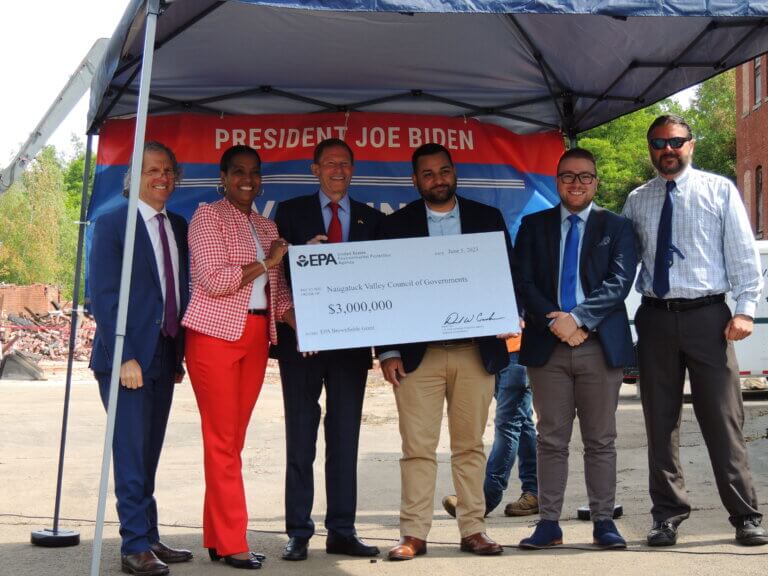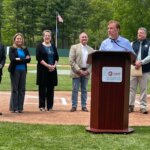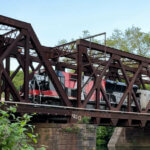Originally posted on June 5th, 2023, reshared on June 6th, 2023 to NVCOGCT.GOV
Click here to access the press release from the U.S. Environmental Protection Agency’s website.
EPA announces the largest investment ever in brownfields communities made by President Biden’s Investing in America Agenda
Contact Information
Jo Anne Kittrell (kittrell.joanne@epa.gov)
BOSTON (June 5, 2023) – Today, the U.S. Environmental Protection Agency (EPA) announced $8,800,000 from President Biden’s Investing in America Agenda to expedite the assessment and cleanup of brownfields sites in Connecticut while advancing environmental justice.
EPA selected six communities in Connecticut to receive six grants totaling $5,800,000in competitive EPA Brownfields funding through the Multipurpose, Assessment, Revolving Loan Fund, and Cleanup (MARC) Grant programs. Thanks to the historic boost from the Bipartisan Infrastructure Law, this is the largest ever funding awarded in the history of the EPA’s Brownfields MARC Grant programs. In addition, the agency is announcing $3,000,000 in non-competitive supplemental funding to one successful existing Revolving Loan Fund (RLF) Grant program to help expedite its continued work at sites in its area by extending the capacity of the programs to provide more funding for additional cleanups.
These investments are part of President Biden’s Investing in America Agenda to grow the American economy from the bottom up and middle-out – from rebuilding our nation’s infrastructure, to driving over $470 billion in private sector manufacturing and clean energy investments in the United States, to creating a manufacturing and innovation boom powered by good paying jobs that don’t require a four-year degree, to building a clean-energy economy that will combat climate change and make our communities more resilient.
“We’re working across the country to revitalize what were once dangerous and polluted sites in overburdened communities into more sustainable and environmentally just places that serve as community assets. Thanks to President Biden’s historic investments in America, we’re moving further and faster than ever before to clean up contaminated sites, spur economic redevelopment, and deliver relief that so many communities have been waiting for,” said EPA Administrator Michael S. Regan. “This critical wave of investments is the largest in Brownfields history and will accelerate our work to protect the people and the planet by transforming what was once blight into might.”

“Congratulations to the seven Connecticut organizations who will receive these new Brownfields grants this year,” said EPA New England Regional Administrator David W. Cash. “Thanks to the Biden-Harris Administration, EPA will be making the single largest investment in Brownfields in history. This funding will revitalize communities across New England, and jump start economic redevelopment and job creation in many of New England’s hardest hit and underserved communities.”
“This historic, desperately needed investment will revitalize and renew pollution threatened communities and boost local economies. Brownfields threaten our environment and hamper local economic development efforts, but these substantial investments for towns across Connecticut will make an invaluable impact in cleaning up the mistakes of the past while building a more sustainable future,” said U.S. Senator Richard Blumenthal. “I am thrilled the EPA is awarding this funding to Connecticut and will keep fighting for more federal dollars to invest in cleaning up our communities.”
“By cleaning up brownfield sites, we can turn blighted and historically underfunded areas into hubs for economic development and job creation,” said U.S. Senator Chris Murphy. “I’m proud that funding from the Bipartisan Infrastructure Law is supporting projects that are good for the environment and will revitalize communities throughout Connecticut that have been stunted by these contaminants.”
“When we passed the Infrastructure Investment and Jobs Act, we delivered the single largest investment to rehabilitate brownfields,” said U.S. Representative Rosa DeLauro. “With the funding allocated from the EPA Cleanup Grant for Waterbury and the EPA RLF Grant for the Naugatuck Valley Council of Governments, our community has been presented an opportunity to address health and environmental concerns and remove barriers to this region’s economic revitalization.”
“For many communities in eastern Connecticut, economic growth is stymied by abandoned properties contaminated from prior use. These new grants will provide New London, East Hampton, and Killingly a fighting chance to revive abandoned property and promote economic growth. This is an excellent example of the federal infrastructure law once again creating new opportunities in our communities,” said U.S. Representative Joe Courtney.
“When we talk about creating an environment where businesses and families can thrive, it begins with cleaning up polluted areas in our communities and creating healthy, livable spaces that spur redevelopment,” said U.S. Representative Jim Himes. “Thanks in part to the Bipartisan Infrastructure Law, the Norwalk Redevelopment Agency and MetroCOG are receiving the funding they need to assess and clean up brownfield sites within the Fourth District. This investment will be critical in propelling the housing developments planned for Norwalk’s Webster Lot and ensuring the safety and economic success of our towns and cities.”
“Every community deserves to be clean, safe, and vibrant. When industrial sites fall into disrepair, and properties become distressed, the children and families around them suffer the most,” said US. Representative Jahana Hayes. “These communities are blocked from economic progress and at greater risk for long-term health issues. We passed the Infrastructure Investment and Jobs Act to give places like Waterbury and the Naugatuck Valley Region the support needed to jumpstart remediation and transform into hubs of opportunity.”
Many communities that are under economic stress, particularly those located in areas that have experienced long periods of disinvestment, lack the resources needed to initiate brownfields cleanup and redevelopment projects. As brownfields sites are transformed into community assets, they attract jobs, promote economic revitalization, and transform communities into sustainable and environmentally just places.
Thanks to the historic $1.5 billion boost from President Biden’s Bipartisan Infrastructure Law, EPA’s Brownfields Program is helping more communities than ever before begin to address the economic, social, and environmental challenges caused by brownfields and stimulate economic opportunity, and environmental revitalization in historically overburdened communities.
EPA’s Brownfields Program also advances President Biden’s Justice40 Initiative to direct 40 percent of the overall benefits of certain Federal investments to disadvantaged communities. The Brownfields Program strives to meet this commitment and advance environmental justice and equity considerations into all aspects of its work. Approximately 84 percent of the MARC program applications selected to receive funding proposed to work in areas that include historically underserved communities.
State Funding Breakdown:
Brownfields Multipurpose, Assessment, Revolving Loan Fund, and Cleanup (MARC) Grant Program Selection
The following organizations in Connecticut have been selected to receive EPA Brownfields funding through the Multipurpose, Assessment, Revolving Loan Fund, and Cleanup (MARC) Grant Programs.
Connecticut Metropolitan Council of Governments, of Bridgeport, Conn., has been selected to receive a $500,000 Brownfields Assessment Grant. Community-wide grant funds will be used to conduct environmental site assessments, prepare reuse strategies and to conduct community engagement activities including Brownfield Working Group meetings. The target area for this grant is the City of Bridgeport and the Towns of Easton, Fairfield, Monroe, Stratford, and Trumbull. Priority sites include vacant lots, a former theater, former commercial and industrial storage facilities, a former metal plating and trucking facility, and an illegal landfill.
The Town of East Hampton has been selected to receive a $500,000 Brownfields Assessment Grant. Community-wide grant funds will be used to conduct environmental site assessments, prepare cleanup plans, and conduct community engagement activities. The focus of this grant is East Hampton’s Village Center section of the Lake Pocotopaug Redevelopment Zone. Priority sites include the Summit Thread North mill site, the Summit Thread South site, and the former East Hampton Bell Company site.
The Town of Killingly has been selected to receive $800,000 for a Brownfields Multipurpose Grant. Grant funds will be used to conduct environmental site assessments and cleanup activities at three properties. All three of these properties are located within the City of Killingly’s Enterprise Corridor Zone. Grant funds also will be used to prepare a Community Engagement Plan, conduct quarterly meetings with neighborhood groups, and to conduct other community engagement activities.
The City of New London has been selected to receive a $1,000,000 Brownfields Revolving Loan Fund (RLF) Grant that will be funded by the Bipartisan Infrastructure Law. The grant will be used to capitalize a revolving loan fund from which the City of New London will provide five loans and up to 12 subgrants to support cleanup activities. Grant funds also will be used to support community engagement and outreach activities. RLF activities will focus on the City of New London’s downtown area, which is now blighted and lacking affordable housing and retail options. Six priority sites have been identified, with four ranked as a high priority since they are all contiguous, vacant, and underutilized prime real estate adjacent to Parade Plaza, Union Station, and the New London Waterfront Park. These include the 10,704-square-foot historic former Capitol Theater and the nationally acclaimed Garde Arts Center.
Norwalk Redevelopment Agency, of Norwalk, Conn., has been selected to receive a $2,000,000 Brownfields Cleanup Grant. Grant funds will be used to clean up the Webster Street Lot located at 55 Dr. Martin Luther King Drive, currently contaminated with metals, petroleum, and volatile organic compounds. Grant funds also will be used to support community outreach activities.
The City of Waterbury has been selected to receive a $1,000,000 Brownfields Cleanup Grant. Grant funds will be used to clean up the Brass City Food Hub site at 777 South Main Street, currently contaminated with a variety of substances including petroleum, polycyclic aromatic hydrocarbons, inorganic contaminants, and heavy metals.
You can read more about this year’s MARC selectees.
Non-competitive Supplemental Funding Through the Existing Revolving Loan Fund (RLF) Grant Program
The Agency is announcing $3,000,000 in non-competitive supplemental funding to one successful existing Revolving Loan Fund (RLF) Grant program that has already achieved success in its work to clean up and redevelop brownfields sites. RLF Grants provide funding for recipients to offer loans and subgrants to carry out cleanup activities at brownfields sites. The funding announced today will help communities continue to address the economic, social, and environmental challenges caused by brownfields sites. The following Connecticutorganization has been selected to receive non-competitive supplemental funding for its existing RLF program.
- Naugatuck Valley Council of Governments ($3,000,000) In addition to the $11,099,850 in EPA funds already awarded, the Naugatuck Valley Council of Governments Brownfield Revolving Loan Fund (RLF) has been selected to receive an additional $3,000,000 through the Bipartisan Infrastructure Law (BIL) because it has a high-performing RLF program with significantly depleted funds. The RLF program has successfully made loans or subgrants leading to 22 cleanup projects that are either completed or in progress. Potential projects highlighted for use of the BIL funding include 526 North Main Street in Waterbury and two Uni-Royal parcels in Naugatuck. The BIL funding will extend the capacity of the program to provide funding for more cleanups in the most underserved areas in the Naugatuck Valley Region.
Read more about this year’s RLF recipients.
Brownfields Technical Assistance Provider for New England
EPA is also announcing funding selection for two Brownfields technical assistance opportunities. The Technical Assistance to Brownfields (TAB) selectees provide specialized technical knowledge, research, and training to help stakeholders understand brownfields-related subject matter, and guide them through the brownfields assessment, clean-up, and revitalization process. This assistance is a key part of the Biden-Harris Administration’s commitment to advance economic opportunities and address environmental justice issues in underserved communities. This technical assistance is available to all stakeholders and comes at no cost to communities. The two funding opportunities announced today include the following:
EPA selected the University of Connecticut (UConn) to receive $5,000,000 to provide training and technical assistance to communities across the state under the Technical Assistance to Brownfields (TAB) Communities Program. This funding comes entirely from the historic $1.5 billion investment from President Biden’s Bipartisan Infrastructure Law. Read more about this year’s TAB selectees.
EPA is also expanding the scope of its technical assistance offerings under the Brownfields and Land Revitalization Program to include three new subject-specific grants totaling $2 million in three areas, including providing technical assistance to nonprofits seeking to reuse brownfields; provide research, outreach, and guidance on minimizing displacement resulting from brownfields redevelopment; and providing outreach and guidance on land banking tactics for brownfields revitalization. Read more on the Brownfields Technical Assistance and Research cooperative agreement recipients.
More information about Brownfields Technical Assistance and Research.
Additional Background:
EPA has selected these organizations to receive funding to address and support the reuse of brownfields sites. EPA anticipates making all the awards announced today once all legal and administrative requirements are satisfied.
EPA’s Brownfields Program began in 1995 and has provided nearly $2.37 billion in Brownfields Grants to assess and clean up contaminated properties and return blighted properties to productive reuse. EPA’s investments in addressing brownfields sites have leveraged more than $36 billion in cleanup and redevelopment. Over the years, the relatively small investment of federal funding has leveraged, from both public and private sources, nearly 260,000 jobs. Communities that previously received Brownfields Grants used these resources to fund assessments and cleanups of brownfields, and successfully leverage an average of 10.6 jobs per $100,000 of EPA Brownfields Grant funds spent and $19.78 for every dollar.
The next National Brownfields Training Conference will be held on August 8-11, 2023, in Detroit, Michigan. Offered every two years, this conference is the largest gathering of stakeholders focused on cleaning up and reusing former commercial and industrial properties. EPA co-sponsors this event with the International City/County Management Association (ICMA).
- More on Brownfields Grants.
- More on EPA’s Brownfields Program.


